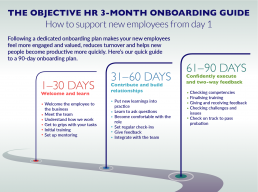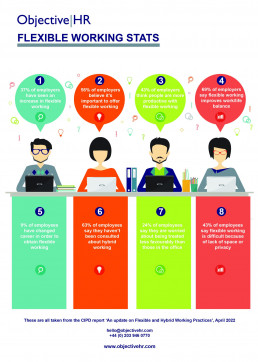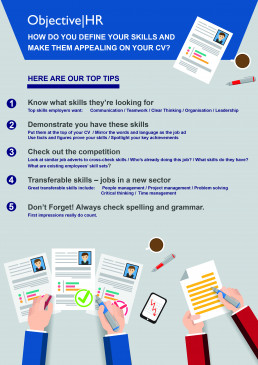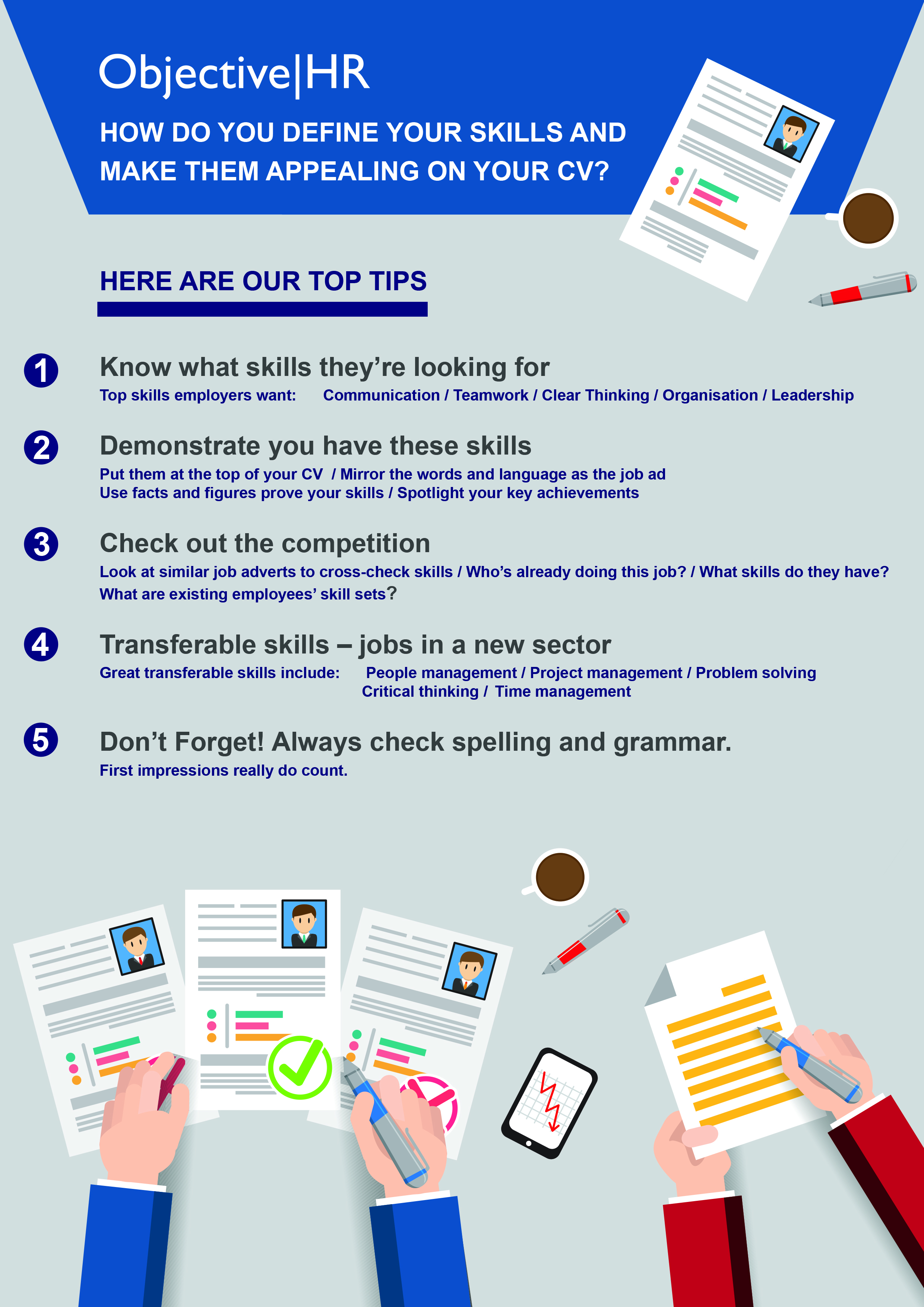Succession planning: Are you doing enough?
Does your business have any succession planning in place? Often, business leadership teams are over 50 and thinking about retirement – or at least reducing their working hours. People who have come through the business together arrive at this point at the same time – meaning that, in some businesses, a significant number of senior leaders are thinking about leaving.
If there is no succession planning in place, this can have an incredibly detrimental effect on the business. And succession planning is about far more than identifying the next person to take on a particular role. It’s about future-proofing the business in line with your strategic plans, and about communicating your planning to your teams, to help get buy-in and aid retention.
In fact, research by Software Advice found that 90% of workers aged 18-34 said that working in a company with a clear succession plan would improve their levels of engagement.
Where to start?
Your first step is to talk to the people in your business who can help you to put a plan together. This come under your governance requirements as a Board, and you might also want to involve your HR team or consultancy, as they can guide you on the best way to manage the process.
Who to choose?
First, think about whether you want to promote from within. This is often a good idea, because you have people who know the business well, who understand your products, services and clients and who you can start to involve in strategy and planning.
Promoting from within also means you can target any learning or development programmes to help build the skills that your successors will need.
If you are going to look for external candidates, make sure you are clear about the skills and approach you need. It must fit with your existing culture so that you can transition well from one leader to another. Leave plenty of time to find the right person, and involve your teams in the process – you may gain valuable insights from them.
Whichever route you go down, make sure you are transparent about your decisions and choices, so that your team can see you have been thoughtful and fair.
Consider communication
The way you tell your people, customers, suppliers and other stakeholders about your succession plan will depend on the timescale you’re working to, and what you feel is best for the business. Again, this is where your HR support can help. They will understand the company and its needs, and be able to put together a clear plan.
Don’t plan it and park it
It can be great to feel you’ve ticked the ‘succession planning’ box, but you must keep it under review. Things change both inside and outside your business, and so there may be times when your succession plan needs updating or revising. Make time to regularly review your plan to make sure it’s still workable.
The Objective HR 3-month onboarding guide
What does ‘onboarding’ mean to your business? For some, it’s about the first day – the first week at most. And then your new employee is expected to be up and running with the minimum amount of support.
But that’s not onboarding. That’s just bringing someone in and telling them to get on with it. Best practice onboarding is about spending time integrating new employees into the culture, processes and working practices of your organisation, giving them the time and support they need to get up to speed and work productively.
Why does it matter?
It’s a good question. And it’s easy to answer. Companies that have a good quality onboarding process tend to find that they:
- Improve retention
- Boost their employer brand
- Achieve greater productivity sooner
- Build a culture of support and open conversation
- Can use feedback to improve their processes
Of all these benefits, the ones that really matter to organisations are often retention and productivity. That’s because getting either of these things wrong costs money. It’s expensive to keep recruiting new people and training them, only to find they leave at, or even before, the end of their probation period.
And of course, you need your people to be productive. So, the more effort you put into designing a process that can help them feel confident and supported in their new role, the quicker you will reach optimum productivity levels.
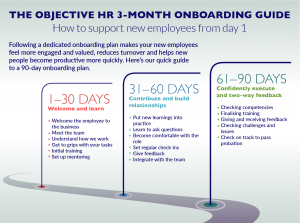
Our 30-60-90 guide
When we work with clients, we use the 30-60-90 model. This encourages managers and HR professionals to see how a good onboarding process can work through the entire probation period. It allows both parties to feedback, learn and engage with each other, helping to build trust and employer brand loyalty.
Most importantly, it gives both the employer and the employee a simple structure to follow, with check-ins and measurements in place. This makes administering the probation period much easier, and lets the employee see exactly what’s expected of them – and what support they will be getting.
We’ve put our guide into this handy infographic – if you’d like to talk to us about how to implement this, or any other HR policies and culture design into your organisation, just contact us today.
Time to check your right to work process?
We’ve read several reports recently about employers not having a complete right to work process in place. And some of those issues have been reflected in conversations we’ve had since the start of the new year.
What’s the problem?
It seems to be that employers aren’t aware of the right to work guidance and are making assumptions about the documents they can use to check that candidates have the right to work in the UK. What’s more, some employers do not store or manage Right to Work information properly even if they’ve collected it. In October last year, the government updated their guidance from the temporary guidance issued during the Coronavirus pandemic – and many employers were completely unaware of the changes, even as they were about to come into force.

What does this mean?
A right to work check is a legal requirement, allowing the employer to demonstrate that they have proof that a candidate is eligible to work legally in the UK. If you fail to do this, you can be subject to a fine of up to £20,000 for each ineligible employee. You’ll also potentially face a custodial sentence, and your business reputation will take a significant knock.
The government’s guide, An employer’s guide to right to work checks, states: “If you conduct the checks as set out in this guide and the code of practice, you will have a statutory excuse against liability for a civil penalty in the event you are found to have employed someone, who is disqualified from carrying out the work in question, by reason of their immigration status.”
So, if you carry out your right to work checks properly, and in line with government guidance, you would not receive a penalty if that worker is later found to be an illegal worker.
What should I be doing?
You should have a clear, written process to help you conduct right to work checks for every hire. This should include:
- Conducting the checks before your new employee starts working for you
- Showing clearly how you will store any personal information, in line with data protection laws
- Having a timetable for re-checking right to work if the individual has a visa or other documentation that comes to an end during their employment with you
There are three approved ways of organising a right to work check:
- A manual check – you are responsible for obtaining documentation from the lists approved by the government. You must then check that documentation to make sure it is genuine, and you must keep a copy of each document in a way that cannot be manually altered. You should also have a separate record of when the checks were undertaken, and you need to store all the relevant information during the period of employment and up to two years after the employment ends.
- An Identity Service Provider check – you can manage your right to work checks digitally by using the Identity Document Validation Technology. To do this, you’ll need to use an approved supplier – the Identity Service Provider. This option is for valid British or Irish passport holders only, and the candidate must agree to this type of check.
- A Home Office check – if your candidate has a current immigration work status, you can use a Home Office service to check this status online. This may not cover all types of immigration work documents, so you may have to use your manual check process instead.
At Objective HR, we can assist with digital right to work checks - they are quick and cost effective. All we need is your candidate’s mobile number and email address. We’ll send them an SMS message to get things started. There’s no need for them to download an app or login to a portal – they simply take a selfie and a photo of their passport. The check usually comes back within 24 hours and we send you a complete Right to Work report that you can keep for your records.

It's worth bearing in mind that 20% of the UK population do not have a passport and would fall out of this process. There are also occasions where individuals do not want to provide their information digitally and so would fall out of the process – in these cases, we can help you to make sure your manual process is thorough and within the government’s requirements.
What's your thinking on flexible work?
A recent report by CIPD has shone an interesting light on how both employers and employees are feeling about flexible - or hybrid - working. Driven, of course, by the pandemic, this has become a key demand from candidates, and we're finding that companies who are sticking rigidly to office-based working are struggling to recruit.
Of course, there's a balance to be had, and we're working closely with our clients to help them construct flexible working processes that are legal, fair and support good quality recruitment and retention. Below are some of the stats we've found most interesting - if you'd like to talk to us about how to design your own flexible working approach, just contact us today.
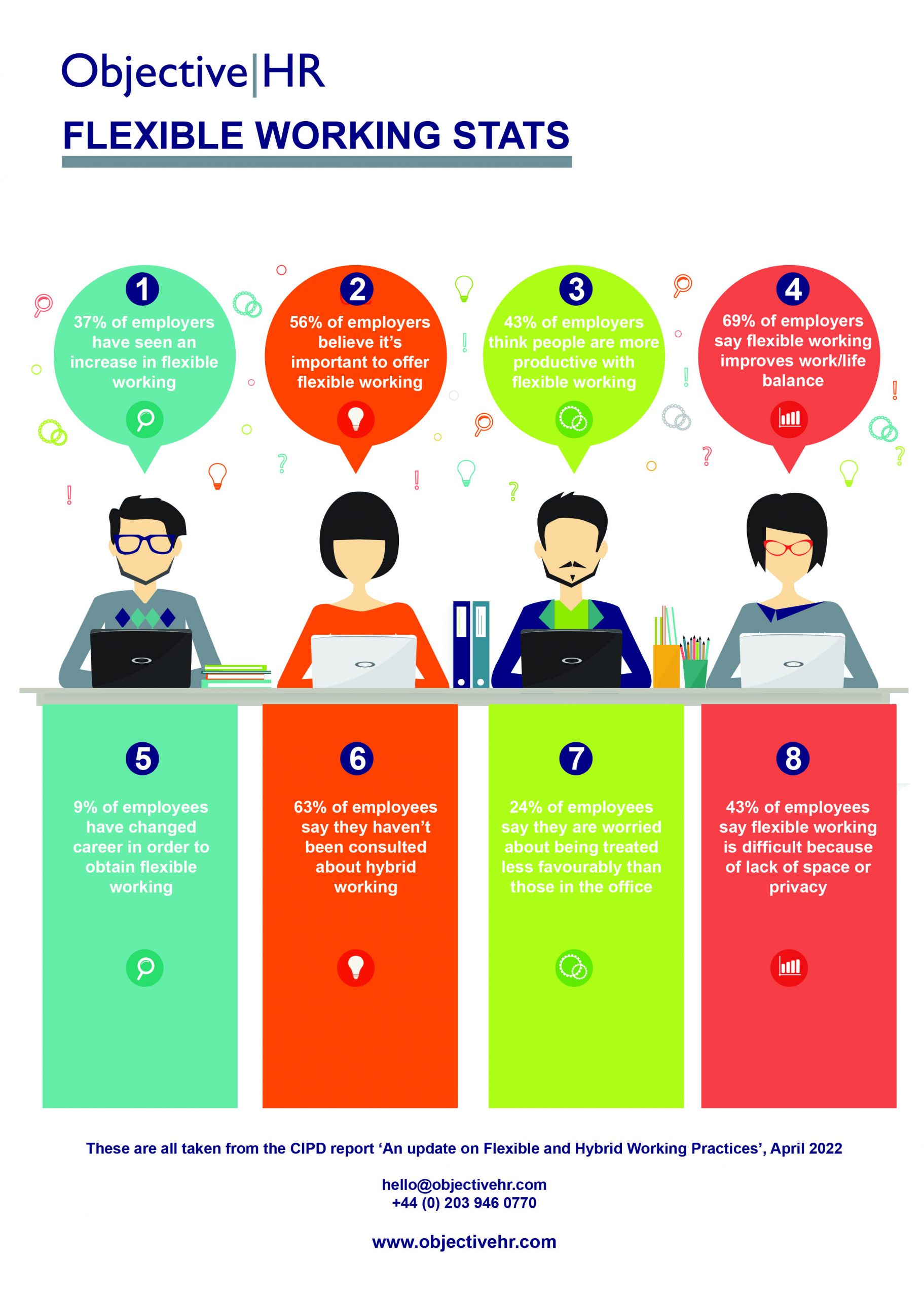
The four surprising things about workplace stress

There is – quite rightly – a lot of information around concerning stress in the workplace. Our jobs can be one of the major causes of stress, or can exacerbate the stressful situations we are experiencing in our home and private lives.
But are we approaching stress at work in the right way? There’s certainly a lot of advice for businesses, but as HR professionals, we’ve got four surprising facts about stress that might help you to plan better from the very beginning. Better planning means reduced risk, and that puts you and your people in a much healthier position from the outset.
Fact 1: Work pressure causes stress
Stress is often caused by external factors. At work, that means your organisation could be responsible for the stress people feel when they are under particular pressure. Look at the way you manage high pressure situations, and they way you support people through these times. Remember that while some people thrive under pressure, others find it very stressful, so be more aware of the individuals in your team and how they react in these circumstances.
Fact 2: Poor organisation is stressful
Your people need to know what is expected of them, who they are reporting to, and where their place is within the organisation. This is down to you. Think of the three ‘R’s – Role, Responsibilities and Reporting. By making all these things clear, you are giving your employees clear guidance, boundaries and understanding of where they fit into your organisation. This automatically improves wellbeing.
Fact 3: It’s stressful to feel unsupported
Good leaders support their people. Not just when they are obviously stressed, but all the time. Putting in place regular reviews, and ensuring you catch up with individuals informally gives you a better insight into how your team is feeling, and gives you a heads-up when someone may start struggling. Supporting your people is vital to positive collaboration and better productivity.
Fact 4: Good HR planning can reduce stress
If you have clear policies in place and you communicate them well, your people will feel confident about their role, understand the culture of the company and feel better supported in their work. Sudden policy announcements, poor management of disciplinary issues, negative communications and an assumption that the employee is always wrong are commonplace – and they create stress.
In turn, stress reduces productivity, damages teams, increases staff turnover and bruises your brand reputation. If you get your HR and leadership priorities right, you can run a much happier and more productive organisation – and you will automatically be in a position to help your employees manage stress when it occurs.
If you’d like any support or advice on how to manage fundamental HR policies and procedures to manage stress in your organisation, contact us today.
Should you be offering sabbaticals?

A sabbatical is a period of time away from work – usually longer than a standard holiday. There are lots of benefits to the employee and to the employer, because a sabbatical represents an opportunity for new experiences, fresh thinking or even updated qualifications.
Some organisations use sabbaticals as rewards for long service, whilst others are thinking more innovatively about non-work time, including regular time off for volunteering projects or family time as part of their CSR or ESG programmes. So, how can you build positive sabbatical offerings into your organisation?
What is the legal position?
There are no laws in the UK that cover sabbaticals, so HR departments and senior leaders have to create their programmes in the way that works best for each organisation. It is important, however, to make sure that your sabbatical programme doesn’t breach any existing laws – particularly those relating to discrimination and equality.
For example, a request for a sabbatical would come under the same umbrella as a request for flexible working. This means that employees should have worked for the organisation for at least 26 weeks – on a full-time or part-time basis – and should not have made any other requests for flexible working in the past 12 months.
Are sabbaticals paid?
This is really up to each organisation. If you choose to keep paying your employee during their sabbatical, then their existing contract will stay in place, including any benefits they may have. If you decide that sabbaticals will be unpaid, the employee’s contract will usually come to an end, but you can make an agreement with them to return to employment when the sabbatical is finished. You need to make sure that you have clear agreements and that both parties understand their responsibilities before the sabbatical is agreed.
Why are sabbaticals good?
Offering a sabbatical brings benefits for you and your workforce.
It brings new perspectives – whatever your employee chooses to do with their sabbatical, they will return to the workplace with new perspectives, ideas and energy.
It increases skills – your employee may choose to do a further qualification, add to their professional development, or take on a voluntary role. All of these will mean they come back to you with new skills that can benefit the business.
It prevents burnout – giving people a chance to take some time for themselves means you prevent some of the absenteeism and productivity issues around burnout.
It helps with recruitment and retention – candidates are looking for employers who are flexible and offer a wide range of opportunities. Having a good sabbatical offering will help to retain valuable employees and improve your brand reputation.
When we ran a poll on LinkedIn about sabbaticals, 43% of people said they would want to use the period to spend more time with their families, 29% would take the opportunity to travel, 14% said they would study for further qualifications, and the remainder would use the time to volunteer.
Whatever your employees – or you, if you choose to take one – decide to do with your sabbatical, it’s clear that a well-structured and thought-through sabbatical programme can help both your employees and your organisation to thrive.
To find out more about how to build a sabbatical programme, or to ask us about building a more employee-focused culture in your workplace, contact us today.
Photo by Tim Mossholder on Unsplash
Are you on top of your HR risks and mitigations?

Most businesses have some sort of risk assessment. A good business has a risk register that is regularly reviewed to make sure that risks haven’t changed, new risks are added and mitigations are still valid.
For every organisation, part of that risk register should be HR-related. The people working for your business can pose a risk to it in a number of ways, as does being unable to find suitable new staff, for example.
HR risks to consider
What constitutes a risk for HR managers in the context of the wider business? Here are some to consider:
Discrimination – this could occur at several different touchpoints within your organisation, and can result in legal or regulatory penalties. Risks including discrimination at interview, in general working practice, in promotions and development opportunities and for pay rises and benefits.
Legal workers – HR and hiring managers are obliged to check that new employees have the right to work in the UK and have the qualifications and experience they say they have. Without proper screening, organisations may fall foul of employment requirements. This means risking fines, and also incurring the costs of starting recruitment all over again.
Health and safety – in some businesses, there might be a department responsible for just occupational health and safety issues, but in smaller companies, this often falls under the HR function. So you need to be aware of the potential risks in your business operations and be able to show that you have clear and well-communicated policies. You also need to provide relevant personal safety equipment and train existing and new staff so that they are always up to date.
Data – you will be in charge of all employee data. There is a huge risk to the organisation and to individual employees if that data is compromised, lost or stolen. So you should make sure you are following the guidelines on data management, complying with relevant data legislation and have mitigation in place in case of cyberattacks or an internal leak of data.
Theft and fraud – this is a problem in many companies and poses a severe risk to the finances and to the wider reputation of the business. Having procedures in place that help to prevent theft or fraud – including multiple signatories for cheques or payment requests and working closely with the finance department to create solid policies for this area will help to reduce that risk.
This list isn’t exhaustive – there will be particular risks your business faces and, as an HR professional, you will have your own responsibilities as dictated by senior management. Now is the time to put a comprehensive risk register in place if you don’t already have one. Talk to other departments or to the person in charge of risk to make sure that your department is part of the overall risk strategy and make sure you review regularly to make sure your register is still relevant and up to date.
Contact us to find out how we can help.
Are you ready for in-person Right to Work checks?

Before the COVID-19 pandemic, all employers had to conduct Right to Work checks. These were usually done in person and required the employer to have sight of original documents.
By the point of the first lockdown in March 2020, it was impossible for in-person checks to take place, so the government allowed Right to Work checks to take place digitally. This has meant that employees have used video calls, scanned documents and sometimes checks via mobile apps.
Originally, in-person checks were due to start again in May 2021, but the government has extended this to June 21st – the start date of the final step in the roadmap to lockdown easing.
What does this mean for you?
As an employer, the return to in-person checking means that you must now check the applicant’s original documents. For employees, you must be in possession of all the relevant documents needed to confirm that you have the right to work in the UK. You must give these documents to your employer – they will be returned to you – so that they can carry out the appropriate checks.
What are the checks?
Employers have a responsibility to check that:
- The documents are genuine, original and unchanged and belong to the applicant
- The dates for the individual’s right to work in the UK have not expired
- Photos are the same across all documents and you are sure they look like the candidate
- Dates and places of birth are the same across all documents
- The candidate has permission to do the type of job they have applied for, including any limit on the number of hours they can work
- For students, you should ask for evidence of their study and holiday times
- If documents give different names, you should ask for supporting documents, such as a marriage certificate or divorce decree to prove a change of name
Make sure you know what’s needed
There’s a clear guide on the government’s website – the Right to work checks: an employer’s guide. This sets out what’s required in terms of checks for applicants from a range of different areas, including EU, non-EU, EEA and non-EEA applicants. It’s worth checking the guide so that you know exactly what you need to do depending on the candidate.
If you need any support on reintroducing in-person Right to Work checks to your organisation, contact us today.
Onboarding: How are you changing?

If there’s one thing we know about working during a pandemic, it’s how tricky it is to bring new people into the business when we are working remotely.
In pre-COVID times, of course, we would have had a well-thought-out induction process. This would give a new starter not just the legal information they needed, but a chance to meet their team properly, sit in on meetings and discussions and get to know the business and how it works. There would be tours or walkabouts, a desk to get set up, and much more.
Today’s new starter is likely to have a laptop and phone couriered to their door, a Zoom meeting and not much more.
But that will need to change, because our ways of working are changing. Anecdotal evidence suggests that whilst businesses are starting to return to the office, they are also looking at hybrid working, where people use a mixture of office and remote working.
Businesses should also note that ‘remote’ does not equate to ‘home’. Many people want to reduce their commuting hours so would rather work closer to home for a few days each week. For some, that might mean a home office, but others may use co-working facilities, so it’s important to know what sort of facilities your people are working from, so that you can support them accordingly.
Why change your onboarding process?
A good onboarding process can be the difference between your new employee integrating really well into your business, and deciding to leave pretty quickly. You need to make them feel welcome, be clear about their role and responsibilities, and help them to communicate with their line manager and team members. But that’s just the start. Onboarding doesn’t finish after two hours of induction – in order to onboard well, you need to make sure your new starters are supported on an ongoing and regular basis.
Here are some of our key thoughts about updating your onboarding process for today’s workplace:
- Assign a buddy – we’ve seen this work really well in client businesses. A buddy can be on the new starter’s team, or part of a general ‘buddy’ group. Their job is to check in regularly, answer common questions, help to integrate the new starter into the business and give them somewhere to turn to with questions.
- Give line managers clear guidance – whilst initial onboarding is often carried out by the HR team, the ongoing work needs to be done by the new starter’s line manager. So that line manager needs to be engaged with the process, understand its purpose and importance and commit to keeping in touch and making sure the new starter can get to work productively and comfortably.
- Use technology to your advantage – you can use aids like DocuSign to allow new starters to sign contracts, staff handbooks and other paperwork remotely, and you can also use technology to help integrate people into the business. If everyone is still working remotely, why not hold an informal half hour lunch meeting, where people can have a chat over food? Or introduce a coffee break to allow people to have those all-important ‘water cooler’ conversations? Technology allows you to introduce informality into the work day without disrupting positivity.
- Bring new starters into the office – if they are comfortable doing so, arrange for new people to spend a day or half a day in the office. They will get a feel for your workspace – and for the journey – and can get used to the way things work without the office being full of people. If you’re bringing people back into the office on a rota basis, make sure your new starter is in at the same time as members of their team, so that they can meet face-to-face.
Onboarding obviously varies from one company to another. The thing to remember is that you can’t just shoehorn your existing process into a new form. You need to think it through and plan it carefully so that it works within the new way your business is working.
We’re guiding and advising clients on improving their onboarding process to help them motivate and retain productive, engaged staff. Talk to us if you’d like help or advice for doing this in your own business.


